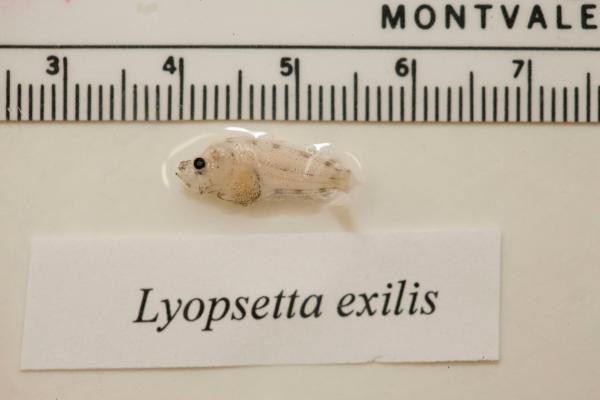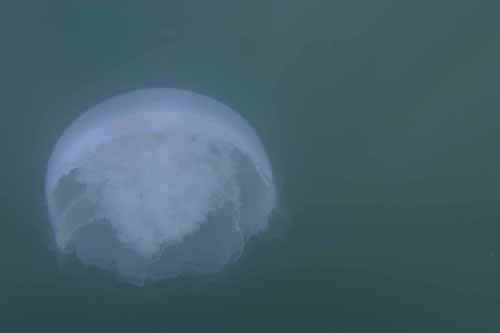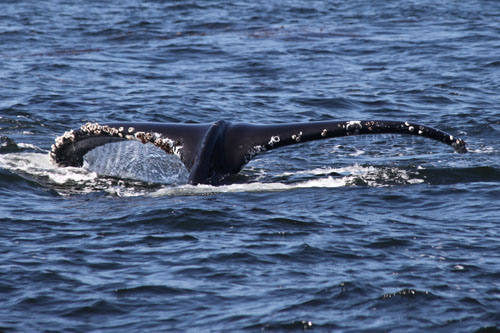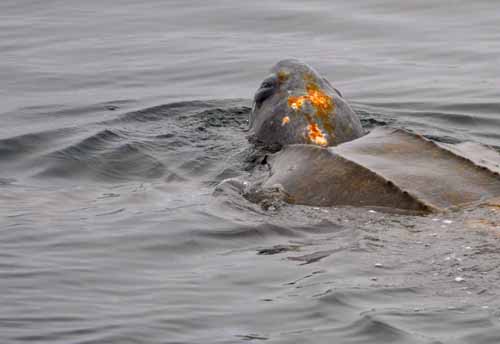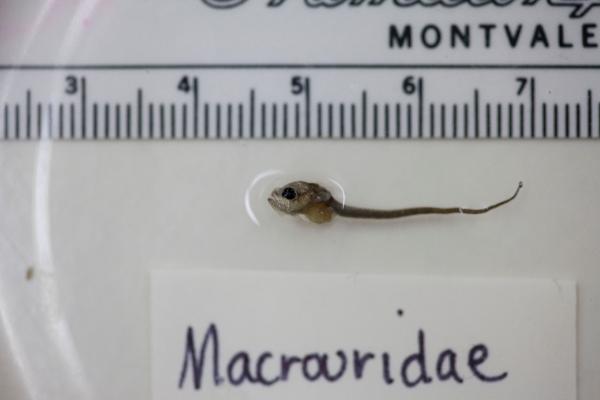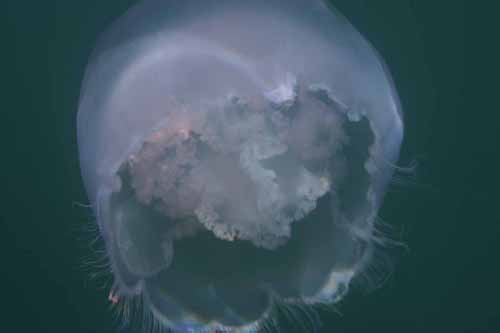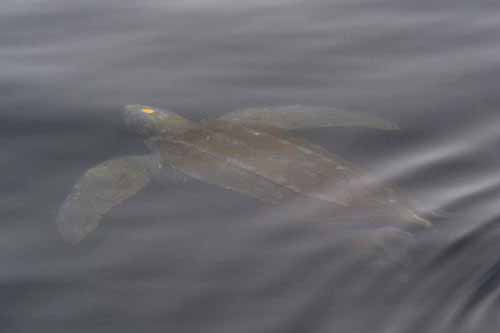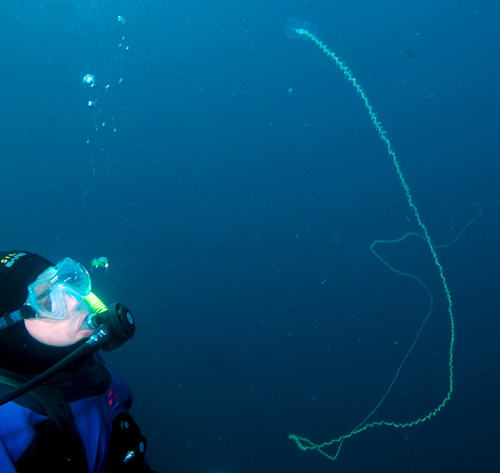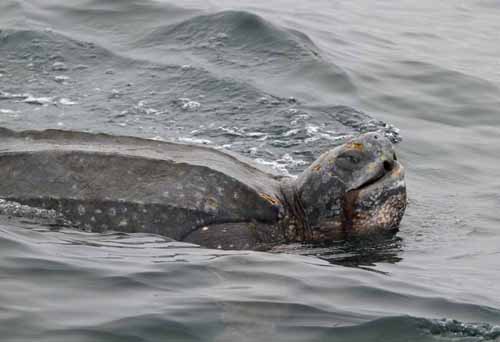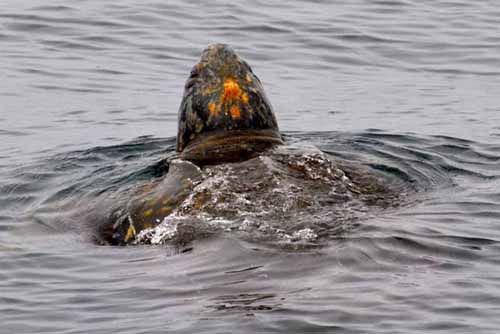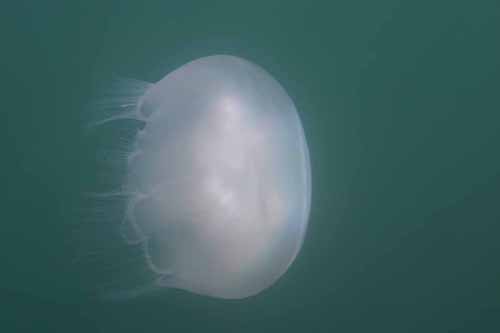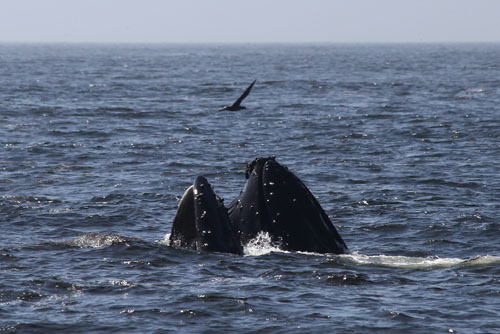Overview
The vast majority of the Monterey Bay National Marine Sanctuary consists of open waters – three-dimensional habitats not associated with the seafloor. These waters are divided by depth into three zones: the epi-, meso- and bathypelagic zones. The epipelagic zone, which includes the upper 200 meters (650 feet) of the water column, is the focus of this section.
The epipelagic zone receives sunlight, which drives photosynthesis in microscopic floating plants called phytoplankton. Phytoplankton form the base of the complex and diverse open-ocean food web.
Upwelling in the spring and summer fuels blooms of phytoplankton, which in turn feed zooplankton and some planktivorous fishes such as anchovies and sardines. Zooplankton (such as larvae, copepods, krill and jellies) are eaten by a wide variety of large, highly mobile animals, including squid, fishes, sea turtles, seabirds and mammals.
Coastal upwelling occurs within about 45 to 50 kilometers (28 to 31 miles) of shore, but alongshore upwelling does not occur uniformly throughout the sanctuary’s coastal waters. There are two upwelling centers in the sanctuary: one near Point Año Nuevo and one south of Point Sur.
Plumes of upwelled water are carried south of these promontories, where they can be retained and recirculated in upwelling shadows; or they move offshore as filaments of high-productivity waters. (Upwelling shadows are warm-water patches that occur in nearshore regions where upwelling is absent and the warm, buoyant surface water is retained inshore of upwelled water.)
Retention zones in upwelling shadows concentrate primary production, which makes these areas attractive to higher trophic level animals. For example, the upwelling shadow within northern Monterey Bay is a foraging “hot spot” for a number of large pelagic organisms, including leatherback turtles, Sooty Shearwaters and harbor porpoise.
The waters around Point Año Nuevo are foraging hot spots for a number of marine mammal and seabird species that use the island for breeding and resting. An increase in white shark abundance in this region during the fall coincides with the peak occurrence of northern elephant seal pups (one to three years of age) – the preferred prey of adult white sharks – on the island.
El Niño events affect the composition and structure of open-ocean communities off central California. Some of the changes appear to be related to reduced upwelling-associated primary production and a subsequent reduction in the biomass of zooplankton and forage fishes.
Decreased food supply during these events contributes to mortality and decreased reproductive success of local predatory fish, seabird and marine mammal populations. In addition, changes in current patterns and increased water temperature are related to immigration of warm-water pelagic species and emigration of cold-water species.
Southern species with elevated abundance in the sanctuary during El Niño events include skipjack tuna, striped marlin, Pacific mackerel, jack mackerel, kelp bass, Pacific barracuda and bluefin tuna. Surprisingly, El Niño events also tend to draw more whales to the sanctuary, possibly because food availability is reduced dramatically offshore.
Commercial, recreational and other human interests play an important role in the open ocean, since many economically valuable resources, such as squid, anchovy, sardine, mackerel, salmon and tunas that demand fair to high market value, are sustained by and caught in this ecosystem. Interestingly, these same resources attract marine organisms, such as white sharks, whales, seals and seabirds; and in some cases conflicts develop between human use and resource protection.
Many human activities, such as commercial vessel traffic, motorized personal watercraft, whale watching and aircraft overflights, have the potential to harm or disturb the natural behavior of open-ocean animals. Monitoring the distribution, behavior and movement patterns of these animals relative to human activities will help to identify those activities that may need to be regulated to ensure healthy populations in sanctuary waters.
Phytoplankton blooms, including harmful algal blooms, have increased in frequency and distribution worldwide since at least 1980. The frequency of blooms may be increasing with nutrient enrichment from agricultural and urban storm runoff and sewage effluent. Although the sanctuary is relatively pristine, there is growing evidence for the role of coastal runoff – due to urbanization, land-use practices and sewage discharge – in stimulating phytoplankton, including potentially harmful organisms.
Monitoring
The open ocean is one of the largest components of the sanctuary, yet it is one of the least understood. The large spatial and long temporal scales at which important processes operate make the system difficult to study; and rough conditions can make research challenging. Furthermore, many open-water organisms are very difficult to study either due to their large size and high mobility (often swimming from one region to another) or their small size and fragility.
Monitoring Harmful Algal Blooms (HABs)
HABs in the sanctuary are usually associated with toxin-producing algae. In May 1998, ongoing monitoring in Monterey Bay detected a bloom of the diatom Pseudo-nitzschia australis, which produces domoic acid, a neurotoxin that was subsequently found in high levels in anchovy, sardines and California sea lions in central California. More than 400 California sea lions died, and many others along the central California coast displayed signs of neurological dysfunction during May and June 1998. Domoic acid has also been implicated in 62 percent of dead, stranded southern sea otters.
Monitoring also tracks dinoflagellates that cause paralytic shellfish poisoning; dinoflagellates that cause diarrhetic shellfish poisoning; dinoflagellates thought to be responsible for the production of yessotoxin (a newly identified problem in California); and Cochlodinium fulvescens, a species first detected in Monterey Bay in July 2004. Dense blooms of C. fulvescens produce a foul-smelling slime and have been associated with fish kills and other damage off Canada, Mexico and Central America. Ongoing monitoring tracks the seasonal abundance and distribution of harmful algal species, trying to identify the conditions under which blooms occur.
Monitoring the Open Water Community over the Monterey Submarine Canyon
Many open-water organisms (e.g., ctenophores, siphonophores, jellies, salps, larvaceans) are fragile and cannot be investigated accurately with conventional sampling methods. The Monterey Bay Aquarium Research Institute’s (MBARI) ROVs, with their sophisticated cameras, samplers and sensors, have afforded investigators the opportunity to spend thousands of hours monitoring and describing open-water organisms. Researchers have found that the discarded mucus houses of larvaceans living in the upper water column sink rapidly and provide a significant amount of organic matter to deep-sea detritivores.
Tagging of Pacific Pelagics (TOPP)
Since 2000, the TOPP research program has been using satellite tagging techniques to monitor the movements of large predators in the North Pacific basin and evaluate how these animals act and interact in their open-ocean habitats. TOPP has tagged 22 different species, including squid (Humboldt squid), fishes (albacore tuna, northern bluefin tuna, ocean sunfish, swordfish, yellowfin tuna), sharks (blue, great white, shortfin mako, salmon), sea turtles (leatherback, loggerhead), seabirds (Black-Footed Albatross, Laysan Albatross, Pink-Footed Shearwater, Sooty Shearwaters), pinnipeds (elephant seals, California sea lions) and whales (blue, fin, humpback, sperm). These data provide a better understanding of how large pelagic organisms move within and use sanctuary resources and highlight the location of foraging and reproductive hot spots and migratory corridors.
Wind to Whales
The Center for Integrated Marine Technologies’ (CIMT) has created a coastal ocean observing and forecasting system for the Monterey Bay region that strives to link the distribution and abundance of zooplankton and large pelagic animals (e.g., sea turtles, seabirds, mammals) to physical oceanographic processes and nutrient availability. In 2005, CIMT instruments recorded a lack of springtime northwest winds and upwelling. This lack of upwelling appeared to be the cause of low zooplankton densities, decreased blue whale sightings and increased numbers of malnourished seabirds.
Photos
Maps
Projects
Application of molecular genetic methods to rockfish predation and habitat association research efforts in Central California
This study used previously developed genetic methods to enhance ongoing research projects in the Monterey Bay National Marine Sanctuary by identifying unknown rockfish (Sebastes spp.) samples to the species level.California Cooperative Oceanic Fisheries Investigations (CalCOFI)
The California Cooperative Oceanic Fisheries Investigations (CalCOFI) was formed in 1949 to study the ecological aspects of the Pacific sardine population collapse off California. Today, the focus has shifted to the study of the marine environment off the coast of California, the management of its living resources, and monitoring the indicators of El Nino and climate change.
Center for Integrated Marine Technologies: Harmful Algal Blooms
Harmful agal blooms (HABs) are the result of rapid growth of toxin-producing unicellular algae. The toxins (e.g., domoic acid) can poison birds and mammals, close fisheries, and pose serious human health risks. The Center for Integrated Marine Technologies (CIMT) is using a variety of techniques to study this phenomenon.Davidson Seamount 2015: Characterization of Mammals, Birds, and Midwater Fishes Above and Adjacent to Davidson Seamount
This multi-disciplined and complex research mission accomplished most of the research goals for areas within the Davidson Seamount Management Zone and other Sanctuary Ecologically Significant Areas (SESAs). The NOAA fishing survey vessel, "Bell M. Shimada" was used as the operational platform. Individual projects completed included the recording of marine mammal and ocean noise with hydrophones, oceanographic data and water sampling with a CTD, collection of water samples for Fukushima isotope analysis (with a CTD), collection of water samples for environmental DNA analysis (with a CTD), mesopelagic fish surveys (with a tucker trawl), marine mammal and seabird surveys were conducted above and adjacent to Davidson Seamount (although most of the surveys occurred in a Beaufort state 6 or above, making the data incomprable), and filming for video production of NOAA research and collaborative Marine Biodiversity Observatory Network (MBON) was completed. Additional proposed research that could not be completed due to ocean conditions included Puma drone surveys to observe marine mammals at DSMZ. Media Day was held off the wharf in Santa Cruz.Ecology and Population Dynamics of White Sharks in the Eastern Pacific: a Case Study
White sharks (Carcharodon carcharias) have been flagged for international protection, yet effective population assessments and management actions have remained hindered by lack of knowledge about the geographical extent and size of distinct populations. Combining satellite tagging, passive acoustic monitoring, visual mark recapture, genetic and stable isotopic analysis we aim to determine white shark critical habitat, migratory patterns foraging ecology and population structure.Field Test of the Puma™ AE (All Environment) Small Unmanned Aircraft System (UAS)
This field-test project used a waterproof, all-electric propeller powered small unmanned aircraft system to find and transmit live video of marine mammals to observers aboard a support vessel in northern Monterey Bay in September 2014. The purpose of this project was to test the efficiency of the aircraft, its reliability in resolving different marine mammal species, and its capability of running more rigorous and traditional transects. Although it proved successful in finding marine mammals, and lacked mechanical problems, it can yet be used to obtain marine mammal densities due to the inability to calculate ocean surface area covered during a flight. In its current configuration, this small unmanned aircraft system may be better suited for reconnaissance and enforcement applications within Monterey Bay National Marine Sanctuary.Rockfish recruitment and ecosystem assessment surveys
The NOAA National Marine Fisheries Service (NMFS) Southwest Fisheries Science Center (SWFSC) Fisheries Ecology Division has conducted annual surveys of the distribution and abundance of pre-recruit stage rockfish as well as other commercially important species such as Pacific whiting in order to provide year-class strength information that can be used in the fisheries management process. Hydgrographic conditions present during the surveys are also examined.Saildrone West Coast Ecosystem Survey
Saildrone provides high-resolution ocean data via a fleet of unmanned surface vehicles (USVs) to NOAA, the Department of Defense, and other US agencies. Saildrone’s USVs are wind-powered vehicles capable of long duration ocean missions (up to 12 months) and carry a sophisticated solar-powered sensor package that streams real-time data to cost-efficiently augment ship-based methods. Saildrone USVs are 23 feet long and 20 feet high, can be launched from any dock, and travel at an average speed of 3-5 knots. The USVs weigh 1200 lbs and have a 7 ft draft.
Sea Turtle Restoration Project: Leatherback Watch Program
The Leatherback Watch Program monitors and records sightings of leatherback sea turtles off the U.S. West Coast.Tracking Black-footed Albatross movements and conservation
Oikonos Ecosystem Knowledge, working with government and university partners has collected data on the oceanic distribution of post-breeding and chick provisioning Black-footed Albatross (Phoebastria nigripes) tagged at two locations (Cordell Bank and Kure Atoll) over four years (2004, 2005, 2007, 2008). Their distribution is described in the context of static oceanic habitats (bathymetric domains and features) and management jurisdictions.Links
Automatic Identification System by NPS
Naval Postgraduate School Ocean Acoustics Laboratory Monitoring Automatic Identification System (AIS) along Central Californiahttp://www.oc.nps.edu/~cwmiller/AIS/
California's Nearshore Waters and Open Ocean
The California Coastal Commission describes habitats in the Monterey Bay.http://ceres.ca.gov/ceres/calweb/coastal/waters.html
FOR SEA, Institute of Marine Sciences
Site offers comprehensive and proven hands-on/minds-on K-12 curriculum guides that are available for purchase. Each lesson has student activities preceded by a "Teacher Background" section which contains key concepts, background information, materials needed, teaching hints, extension ideas, and answer keys.http://www.forsea.org
MARE: Marine Activities, Resources and Education
MARE is an interdisciplinary science program at the Lawrence Hall of Science (UC Berkeley) offering year-round professional development opportunities, including events that immerse your whole school—faculty, students and families—in the study and celebration of the ocean.http://www.lawrencehallofscience.org/MARE/
MBARI - Current Research Projects
Learn about current research projects conducted by the Monterey Bay Aquarium Research Institute (MBARI).http://www.mbari.org/rd/projects/current_projects.html
MBARI - Deep-Sea Guide
A web-based system that allows for the correlation of visual, descriptive, and observational data with environmental data from multiple sources by providing tools for searching, identifying, and examining occurrence data (e.g., depth, time, abundance) for biological, geological, and experimental observations.http://dsg.mbari.org/
Monterey Bay Aquarium - Student and Teacher Resources and Activities
The Monterey Bay Aquarium offers teacher and student resources including: species and habitat-specific information, live cams, classroom activities, and interactive online games.http://www.mbayaq.org/lc/
Monterey Bay Aquarium Open Ocean In The Wild
Site has information on habitats, photos, and species descriptions of organisms that live in the open ocean. Site also offers a glossary.http://www.mbayaq.org/efc/efc_hp/hp_open_wild.asp
Monterey Bay National Marine Sanctuary - Pelagic Zone
A comprehensive and educational scientific characterization of an important habitat in the Monterey Bay Sanctuary.http://montereybay.noaa.gov/sitechar/pelagic.html
NOAA - Ocean Explorer Program
Explore the ocean realm with NOAA. This Web site chronicles the adventures and discoveries of NOAA's at-sea science and education teams.http://oceanexplorer.noaa.gov/welcome.html
NOAA - Ocean Explorer Program
Explore the ocean realm with NOAA. This Web site chronicles the adventures and discoveries of NOAA's at-sea science and education teams.http://oceanexplorer.noaa.gov/
Office of the Naval Research - Science and Technology Focus
This site is packed with ocean facts and information, including some naval discoveries. Lessons and activities are included.http://www.onr.navy.mil/focus/ocean/
Overview of Harmful Algal Blooms (HABs)
See how National Centers for Coastal Ocean Science (NCCOS) is acting to respond to the growing threat of harmful algal blooms, which can devastate local economies as well as pose a risk to human health.http://www.cop.noaa.gov/stressors/extremeevents/hab/default.aspx
Project Oceanography - MBNMS
A University of South Florida distance-learning program for middle school students taught by scientific experts. "Unit II: Monterey Bay National Marine Sanctuary" contains teacher packets on various topics.http://www.marine.usf.edu/pjocean/packets/sp02/sp02.htm
Tagging of Pacific Predators: near real-time animal tracks
Images of near real-time satellite tracking data of pelagic species of sharks, mammals, and turtles.http://topp.org/
The Pacific Shark Research Center (PSRC) at Moss Landing Marine Laboratories
The PSRC at MLML conducts both basic and applied scientific research on the biology of Pacific Ocean chondrichthyans, serves as a resource center for scientific information on sharks to public policy makers, and participates in collaborative research on national and international issues involving shark, ray, and chimaera biology.http://psrc.mlml.calstate.edu/
